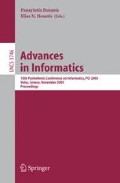Abstract
Discrete sequence modeling and prediction is a fundamental goal and a challenge for location-aware computing. Mobile client’s data request forecasting and location tracking in wireless cellular networks are characteristic application areas of sequence prediction in pervasive computing, where learning of sequential data could boost the underlying network’s performance. Approaches inspired from information theory comprise ideal solutions to the above problems, because several overheads in the mobile computing paradigm can be attributed to the randomness or uncertainty in a mobile client’s movement or data access. This article presents a new information-theoretic technique for discrete sequence prediction. It surveys the state-of-the-art solutions and provides a qualitative description of their strengths and weaknesses. Based on this analysis it proposes a new method, for which the preliminary experimental results exhibit its efficiency and robustness.
Access this chapter
Tax calculation will be finalised at checkout
Purchases are for personal use only
Preview
Unable to display preview. Download preview PDF.
References
Apostolico, A., Bejerano, G.: Optimal amnesic probabilistic automata or how to learn and classify proteins in linear time and space. Journal of Computational Biology 7(3-4), 381–393 (2000)
Begleiter, R., El-Yaniv, R., Yona, G.: On prediction using variable order Markov models. Journal of Artificial Intelligence Research 22, 385–421 (2004)
Bejerano, G., Yona, G.: Variations on probabilistic suffix trees: Statistical modeling and prediction of protein families. Bioinformatics 17(1), 23–43 (2001)
Bhattacharya, A., Das, S.K.: LeZi-Update: An information-theoretic framework for personal mobility tracking in PCS networks. ACM/Kluwer Wireless Networks 8(2-3), 121–135 (2002)
Chen, X., Zhang, X.: A popularity-based prediction model for Web prefetching. IEEE Computer 36(3), 63–70 (2003)
Cleary, J.G., Witten, I.H.: Data compression using adaptive coding and partial string matching. IEEE Transactions on Communications 32(4), 396–402 (1984)
Curewitz, K.M., Krishnan, P., Vitter, J.S.: Practical prefetching via data compression. In: Proceedings of the ACM International Conference on Data Management (SIGMOD), pp. 257–266 (1993)
Das, S.K., Cook, A., Bhattacharya, D.J., Heierman, E.O., Lin, T.-Y.: The role of prediction algorithms in the MavHome smart home architecture. IEEE Wireless Communications 9(6), 77–84 (2002)
Deshpande, M., Karypis, G.: Selective Markov models for predicting Web page accesses. ACM Transactions on Internet Technology 4(2), 163–184 (2004)
Ehrenfeucht, A., Mycielski, J.: A pseudorandom sequence – How random is it? American Mathematical Monthly 99(4), 373–375 (1992)
Feder, M., Merhav, N.: Relations between entropy and error probability. IEEE Transactions on Information Theory 40(1), 259–266 (1994)
Gusfield, D.: Algorithms on Strings, Trees, and Sequences: Computer science and computational biology. Cambridge University Press, Cambridge (1997)
Katsaros, D., Manolopoulos, Y.: Web caching in broadcast mobile wireless environments. IEEE Internet Computing 8(3), 37–45 (2004)
Katsaros, D., Manolopoulos, Y.: Prediction in wireless networks by variable length Markov chains (2005) (Manuscript in preparation)
Krishnan, P., Vitter, J.S.: Optimal prediction for prefetching in the worst case. SIAM Journal on Computing 27(6), 1617–1636 (1998)
Largeron-Leténo, C.: Prediction suffix trees for supervised classification of sequences. Pattern Recognition Letters 24(16), 3153–3164 (2003)
Misra, A., Roy, A., Das, S.K.: An information-theoretic framework for optimal location tracking in multi-system 4G wireless networks. In: Proceedings of the IEEE International Conference on Computer Communications (INFOCOM), vol. 1, pp. 286–297 (2004)
Nanopoulos, A., Katsaros, D., Manolopoulos, Y.: A data mining algorithm for generalized Web prefetching. IEEE Transactions on Knowledge and Data Engineering 15(5), 1155–1169 (2003)
Pitkow, J., Pirolli, P.: Mining longest repeating subsequences to predict World Wide Web surfing. In: Proceedings of the USENIX Symposium on Internet Technologies and Systems (USITS), pp. 139–150 (1999)
Ron, D., Singer, Y., Tishby, N.: The power of amnesia: Learning probabilistic automata with variable memory length. Machine Learning 25(2-3), 117–149 (1996)
Roy, A., Das, S.K., Misra, A.: Exploiting information theory for adaptive mobility and resource management in future wireless cellular networks. IEEE Wireless Communications 11(4), 59–65 (2004)
Volf, P.: Weighting techniques in data compression: Theory and algorithms. PhD thesis, Technische Universiteit Eindhoven (2002)
Willems, F.J.: The context-tree weighting method: Extensions. IEEE Transactions on Information Theory 44(2), 792–798 (1998)
Willems, F.J., Shtarkov, Y.M., Tjalkens, T.J.: The context-tree weighting method: Basic properties. IEEE Transactions on Information Theory 41(3), 653–664 (1995)
Author information
Authors and Affiliations
Editor information
Editors and Affiliations
Rights and permissions
Copyright information
© 2005 Springer-Verlag Berlin Heidelberg
About this paper
Cite this paper
Katsaros, D., Manolopoulos, Y. (2005). A Suffix Tree Based Prediction Scheme for Pervasive Computing Environments. In: Bozanis, P., Houstis, E.N. (eds) Advances in Informatics. PCI 2005. Lecture Notes in Computer Science, vol 3746. Springer, Berlin, Heidelberg. https://doi.org/10.1007/11573036_25
Download citation
DOI: https://doi.org/10.1007/11573036_25
Publisher Name: Springer, Berlin, Heidelberg
Print ISBN: 978-3-540-29673-7
Online ISBN: 978-3-540-32091-3
eBook Packages: Computer ScienceComputer Science (R0)

